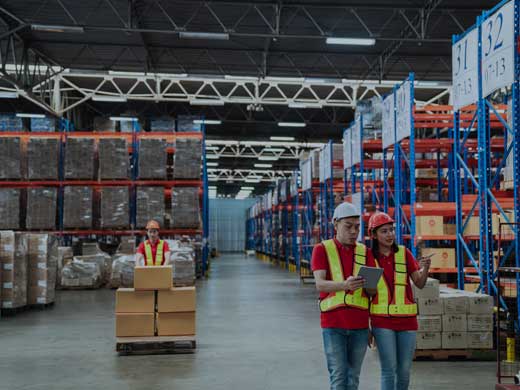Faced with inflation, competition and low margins, you’re optimizing your food and beverage (F&B) business from top to bottom. Naturally, you’ve looked for technology to support your efforts. From research, you know that the right ERP system can take your optimization quest to a whole new level.
You know that ERPs can streamline or automate processes and give you real-time visibility into your operations so you can make data-driven decisions faster. You may not know, though, about these 10 tips on getting more out of your ERP system. We hope you’ll find them helpful!
1. Shortlist ERP vendors that offer industry-specific systems

Your F&B business has a distinctive set of requirements that must be expertly managed. So your ERP system needs to be up to the task for two key reasons.
First, compliance is complicated. Food safety standards (e.g., GFSI, SQF, ISO), traceability needs and a multitude of other guidelines and regulatory requirements must be efficiently attended to.
Second, for an F&B business to be efficient, it must have full visibility into recipe management, shelf life and lot tracking.
A generic ERP system cannot respond to these distinctive requirements without undergoing expensive customizations.
But ERP vendors who have experience and expertise in the F&B sector can recommend software that will provide you with tremendous support in your quest to optimize your business.
2. Be efficient in compliance with food safety regulations

No F&B business wants to hear the food inspector knock on their door.
To protect both your customers and your reputation, an F&B-focused ERP system can facilitate compliance through functions such as allergen tracking, recall management and quality assurance protocols.
Such an ERP can help identify:
- Where questionable components may be sourced from
- Which products include these components
- What other products these questionable components have been in contact with
- The destination of the questionable products.
3. Enhance your supply chain management

You want to reduce stockouts, minimize carrying costs, improve order accuracy, and enhance overall supply chain efficiency.
Your ERP system can provide invaluable support toward these goals. For example, your analytics tool can create cost, efficiency and profitability assessments for various supply chain-related resources (such as transportation, raw materials, labour).
With these assessments in hand, you have options. You can enter pricing discussions with your suppliers armed with a list of priorities and data-based insights.
Or, you may seek backup sourcing arrangements, either with suppliers from the same region or others.
4. Use inventory and production planning to reduce waste and inefficiency

Working with perishable inventory, you battle daily against waste. Maybe you bought too much of a component. Or, expected orders did not come through. Perhaps plant equipment malfunctioned.
Fortunately, your ERP system provides full real-time visibility into your inventory, sales and production.
Through your ERP’s forecasting modules, you can plan precisely what stock levels you’ll need to meet customer demand, how long your production equipment will run, and how much time your workforce will have to spend.
Furthermore, your ERP enables you to explore different business outcomes by entering a variety of variables into your forecasting module. As a result, you can evaluate several data-based scenarios before making decisions.
5. Embrace real-time data analytics to make better decisions faster

To support your decision-making, your ERP’s analytics work as a data-mining tool. By reviewing large collections of your historical data, the tool finds patterns and trends based on your query.
For example, you could ask questions such as:
- What five items are selling the most per season?
- Which markets are the greatest source of profitable sales?
- Which aspect of your production chain is the most efficient?
- Which suppliers provide the highest quality materials?
- What trends are there in your equipment breakdowns/downtime?
- When are customer returns at their highest?
With these insights in hand, you can proactively identify opportunities and address areas for improvement
6. Elevate recipe and formula management

Maintaining consistent product quality is essential to customer satisfaction.
Yet, you also want to be efficient about quality. Can your team provide a data-based answer when you ask, “Is our recipe truly optimal?”
For example, can they look at your KPI for the production efficiency of a recipe and say the following:
- Our KPI number for efficiency considers all contributing elements (e.g., recipe errors, raw material loss due to past-expiry waste, losses of finished products, and so on).
- Our variance between the estimated and actual performance of the recipe, in real time, is X.
With the right ERP system, you get precise real-time answers to your question, “Is our recipe truly optimal?”
Furthermore, the ERP’s recipe management functions enable you to standardize formulas, track ingredient costs and ensure consistency across production batches.
Your customers will appreciate the product consistency, and you’ll love the real-time insight into your operations.
7. Automate order processing

If a company is not working with an ERP, some business documents like sales orders, supplier invoices, and receiving slips may be entered manually multiple times before they are completely processed. These duplicated efforts are costly and increase the risk of error.
In contrast, an ERP’s centralized database and processing enable you to streamline numerous company processes to boost your productivity.
For example, consider a sales order. Once it’s entered into your ERP system, the purchasing, inventory, production, and shipping modules are automatically and precisely updated. No one else needs to re-enter the order.
Furthermore, that order is automatically tracked as it makes its way through your company. Any authorized person can instantly look into its progress. Even invoicing, once the product is packed and shipped, is automated.
Moreover, when your customer service team has to respond to inquiries about an order or your operations team needs to follow up on it, everyone on your team can react quickly.
8. Improve shelf-life management

When you’ve got hundreds or thousands of perishable components on your shelves, staying on top of their best-by dates can be a frantic, costly task.
To minimize waste, maintain product quality and optimize profitability, your ERP system can do the following:
- Track shelf-life dates
- Reduce waste by notifying you about expiring or expired products
- Implement first-expiry-first-out (FEFO) or first-in-first-out (FIFO) inventory management
9. Connect field operations to your office through mobile access

Using your existing IT infrastructure and a cloud-based ERP system, you can help all your remote employees improve productivity and support customers.
For example, when your salespeople, delivery drivers and remote staff connect to your ERP, they gain real-time opportunities to access valuable information, help customers, and make better decisions as they support your business goals.
Through an additional small investment in RFID-based mobile readers (e.g., tablets), you can also connect your warehouse team to your inventory system. Using these devices, your employees can read barcodes on incoming or outgoing goods.
This scanning eliminates a lot of data entry and the associated risk of error that comes with paperwork moving through your company.
10. Invest in training after ERP implementation

Any tool is only as effective as the skill of the user.
To reap the full optimization benefits of your ERP system, your team must be trained to take advantage of your system’s capabilities.
If employees are frustrated because they’re not getting adequate support on the system, they may devise manual workarounds. As a result, that business function will revert to what it was before your ERP integration: an independent silo of information.
So it’s important to schedule training sessions beyond the initial instruction delivered when implementing the system.
One option for providing ongoing support is to train your power users in the ERP’s more advanced functions. Then have them train their colleagues.
Another option would be simply having your ERP vendor offer your employees refresher courses or more advanced training at regular intervals.
Want to learn more about how to get more out of your ERP system for your F&B business? Connect with us to get answers to your questions or benefit from a personalized demo.





